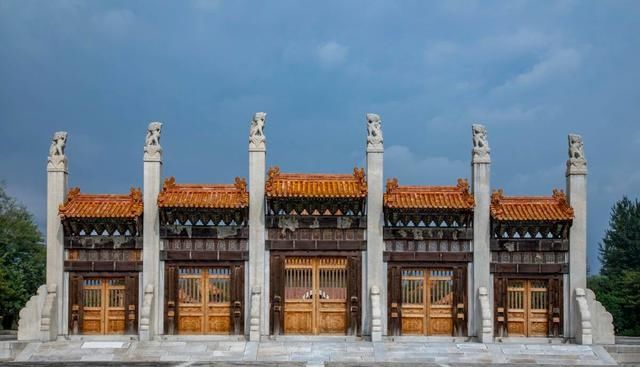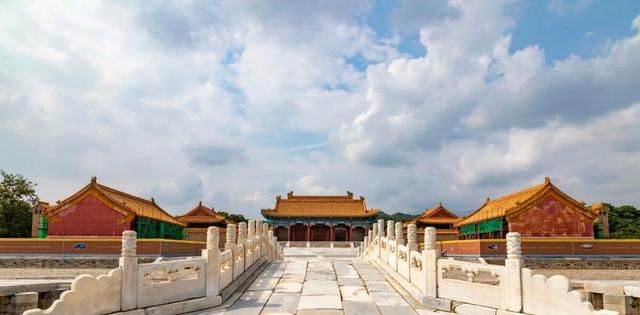- · 《自然与文化遗产研究》[05/29]
- · 《自然与文化遗产研究》[05/29]
- · 《自然与文化遗产研究》[05/29]
- · 《自然与文化遗产研究》[05/29]
- · 《自然与文化遗产研究》[05/29]
- · 《自然与文化遗产研究》[05/29]
国内文旅|世界文化遗产之明清皇家陵寝(中)清
作者:网站采编关键词:
摘要:“明清皇家陵寝依照风水理论,精心选址,将数量众多的建筑物巧妙地安置于地下。它是人类改变自然的产物,体现了传统的建筑和装饰思想,阐释了封建中国持续五千余年的世界观与

“明清皇家陵寝依照风水理论,精心选址,将数量众多的建筑物巧妙地安置于地下。它是人类改变自然的产物,体现了传统的建筑和装饰思想,阐释了封建中国持续五千余年的世界观与权力观。”以上是2000年明清皇家陵寝被列入世界遗产名录时,世界遗产委员会对其作出的评价。

明清两朝是中国古代陵寝建设的辉煌期与高峰期。明代开国皇帝朱元璋对陵寝制度进行了改革,将地面之上的封土堆改成圆形,并扩大地面祭殿建筑建设。其死后入葬的孝陵成为明清皇家陵寝的鼻祖。清代承袭了明代的皇家陵寝制度,并在祭祀制度上加以完善,使之更趋合理。

清东陵位于河北唐山遵化市西北,前有金星山为屏,中有影壁山为案,后有昌瑞山为靠,东西有两条大河似玉带般蜿蜒环绕。陵园占地78平方公里,自1661年清代初期开始陆续建有15座陵园,其中皇帝陵5座、皇后陵4座、妃园寝5座、公主园寝1座,共埋葬161人。各陵园以孝陵为中轴线,依山势呈扇形排列于昌瑞山南麓,主次分明、尊卑有序。各陵按”前朝后寝”规制营建了一系列建筑,均由碑楼、宫墙、隆恩殿、东西配殿、方城明楼及宝顶等建筑组成,使各建筑之间达到了近乎完美的空间组合。

孝陵是清朝开国皇帝、清世祖顺治帝的陵寝,被誉为昌瑞山第一陵。孝陵建设时正值清朝入主中原初期,民生凋零、财力匮乏。但是孝陵的18对石像生分布在870米的神路之上,造型古朴威武,反映出满清初期在马背上打天下的雄浑气魄。
景陵与裕陵分别是谱写清代“康乾盛世”的两位君主——康熙与乾隆的陵寝。他们建树甚多,所以陵寝也建设得相对富丽堂皇。特别是裕陵地宫雕满佛教图案,显示出太平盛事里佛教作为皇家宗教信仰的盛行。

定陵和定东陵则是清王朝由盛及衰的写照。定陵的主人咸丰皇帝在位期间已面临内忧外患。而定东陵的主人之一慈禧则因两度“垂帘听政”而更为世人瞩目。定东陵三座贴金大殿的豪华装修举世罕见,还有殿前"凤上龙下 “的丹陛石雕更体现了她对权力的欲望与野心。

清东陵的建设跨越了两个半世纪,几乎与清王朝相始终,是一部用砖、木、瓦、石写就的清王朝盛衰的历史。清东陵在与周围自然环境融合、与山川形势结合上日趋完美,是中国陵墓营建活动高峰期的代表作。
【全文翻译】
“The Ming and Qing imperial tombs are natural sites modified by human influence, carefully chosen according to the principles of geomancy (Fengshui) to house numerous buildings of traditional architectural design and decoration. They illustrate the continuity over five centuries of a world view and concept of power specific to feudal China.” This is the description made by the World Heritage Committee when the Imperial Tombs of the Ming and Qing Dynasties was inscribed on the World Heritage List in 2000.

Ming and Qing dynasties were the heyday of imperial mausoleum construction in ancient China. The first emperor of Ming dynasty, Zhu Yuanzhang, reformed the mausoleum traditions by changing the grave mound into circular shape and expanding the construction of overground funerary architecture. The Xiaoling Tomb, where Zhu Yuanzhang was buried after his death, became the originator of the imperial tombs of the Ming and Qing dynasties. Qing dynasty inherited the imperial mausoleum traditions of Ming dynasty, and improved the sacrifice system to be more reasonable.

Located at the northwest of Zunhua, Tangshan, Hebei Province, the Eastern Qing Tombs are screened by the Jinxing Mountain, fronted by the Yingbi Mountain and seated against the Changrui Mountain, with two rivers on east and west sides winding around. Covering an area of 78 square kilometers, the Eastern Qing Tombs consist of 15 mausoleums (5 for emperors, 4 for empresses, 5 for concubines and 1 for princess) which were built successively since 1661 at the early stage of Qing dynasty, and 161 people altogether were buried here. With Xiaoling Tomb as the axis, the 15 mausoleums are arranged fan-like on the south side of Changrui Mountain according to seniority and precedence in rank. In the style of “courts in front and dwellings in the back”, all mausoleums are made up of a set of architectures, including stele pavilion, palace walls, Long'en Hall, eastern and western side halls, square city, memorial tower, treasure peak, etc., forming a perfect spatial combination of all buildings.
文章来源:《自然与文化遗产研究》 网址: http://www.zrywhycyj.cn/zonghexinwen/2021/0330/1088.html
自然与文化遗产研究投稿 | 自然与文化遗产研究编辑部| 自然与文化遗产研究版面费 | 自然与文化遗产研究论文发表 | 自然与文化遗产研究最新目录
Copyright © 2018 《自然与文化遗产研究》杂志社 版权所有
投稿电话: 投稿邮箱: